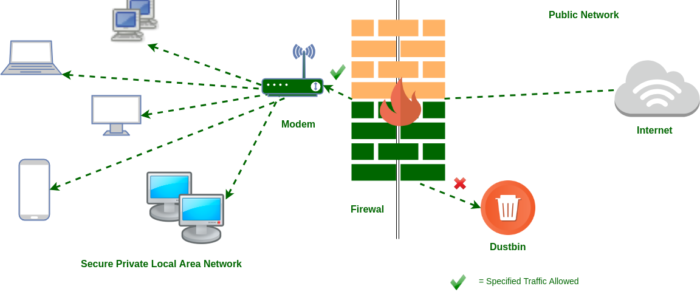Next-Generation Firewall (NGFW)
Next Generation Firewall (NGFW) is a cyber security solution that creates unique benefits for the companies using it. NGFW is able to block malware from entering a network. Next Generation Firewall monitors, filters, and controls incoming and outgoing network traffic
The Challenge
- Organizations want to get more out of their existing security investments, but they are challenged today.
- Network security operations largely remain manual, laborious and reactive.
- Many businesses are unaware of their network security posture or have limited insight into misconfigurations, which can lead to gaps in their security posture and put them at a greater risk of a breach.
- Organizations facing skill shortages may not have the product expertise to fully maximize firewall functionality, resulting in security investments that don’t yield proportional returns.
- Finally, organizations lack the visibility and product knowledge to prevent business-disrupting incidents from firewall-related errors. Once impacted, they spend immense time and resources reacting to the situation, trying to determine the root cause while under tremendous pressure to bring the business back online.
The Solution
A Next-Generation Firewall (NGFW) is a cyber security solution to protect network fronts with capabilities that extend beyond traditional firewalls.
NGFW
Reduce the attack
surface and strengthen security posture with a next generation firewall (NGFW)
NGFW protects network fronts with capabilities that extend beyond traditional firewalls. While traditional firewalls detect suspicious traffic and block network access based on a predefined blacklist, NGFW includes additional features such as intrusion prevention and deep packet inspection.
What is a next-generation firewall (NGFW)?
A traditional firewall provides stateful inspection of network traffic. It allows or blocks traffic based on state, port, and protocol, and filters traffic based on administrator-defined rules.
A next-generation firewall (NGFW) does this, and so much more. In addition to access control, NGFWs can block modern threats such as advanced malware and application-layer attacks. According to Gartner’s definition, a next-generation firewall must include:
- Standard firewall capabilities like stateful inspection
- Integrated intrusion prevention
- Application awareness and control to see and block risky apps
- Threat intelligence sources
- Upgrade paths to include future information feeds
- Techniques to address evolving security threats
What should I look for in a next-generation firewall?
1. Breach prevention and advanced security
The No. 1 job of a firewall should be to prevent breaches and keep your organization safe. But since preventive measures will never be 100 percent effective, your firewall should also have advanced capabilities to quickly detect advanced malware if it evades your front-line defenses. Invest in a firewall with the following capabilities:
- Prevention to stop attacks before they get inside
- A best-of-breed next-generation IPS built-in to spot stealthy threats and stop them fast
- URL filtering to enforce policies on hundreds of millions of URLs
- Built-in sandboxing and advanced malware protection that continuously analyzes file behavior to quickly detect and eliminate threats
- A world-class threat intelligence organization that provides the firewall with the latest intelligence to stop emerging threats
2. Comprehensive network visibility
You can’t protect against what you can’t see. You need to monitor what is happening on your network at all times so you can spot bad behavior and stop it fast. Your firewall should provide a holistic view of activity and full contextual awareness to see:
- Threat activity across users, hosts, networks, and devices
- Where and when a threat originated, where else it has been across your extended network, and what it is doing now
- Active applications and websites
- Communications between virtual machines, file transfers, and more
3. Flexible management and deployment options
Whether you are a small to medium-sized business or a large enterprise, your firewall should meet your unique requirements:
- Management for every use case–choose from an on-box manager or centralized management across all appliances
- Deploy on-premises or in the cloud via a virtual firewall
- Customize with features that meet your needs–simply turn on subscriptions to get advanced capabilities
- Choose from a wide range of throughput speeds
4. Fastest time to detection
The current industry standard time to detect a threat is between 100 to 200 days; that is far too long. A next-generation firewall should be able to:
- Detect threats in seconds
- Detect the presence of a successful breach within hours or minutes
- Prioritize alerts so you can take swift and precise action to eliminate threats
- Make your life easier by deploying consistent policy that’s easy to maintain, with automatic enforcement across all the different facets of your organization
5. Automation and product integrations
Your next-generation firewall should not be a siloed tool. It should communicate and work together with the rest of your security architecture. Choose a firewall that:
- Seamlessly integrates with other tools from the same vendor
- Automatically shares threat information, event data, policy, and contextual information with email, web, endpoint, and network security tools
- Automates security tasks like impact assessment, policy management and tuning, and user identification
Why do I need a next-generation firewall?
Targeted and sophisticated security threats are causing more damage to internal networks than ever before. Traditional firewall technologies are heavily reliant on port/protocol inspection, which is ineffective in a virtualized environment where addresses and ports are assigned dynamically.
By comparison, a next-generation firewall uses deep-packet filtering to inspect the contents of packets, provides layer 7 application filtering, and can even monitor and block suspicious activity. These capabilities are a must to ensure security in a complex, dynamic environment.
What are the features of next-generation firewall (NGFW)?
A next-generation firewall includes the following features:
- Application and user control
- Integrated intrusion prevention
- Advanced malware detection such as sandboxing
- Leverages threat intelligence feeds




